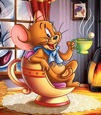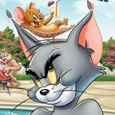Famous Studios (1951-1962), Classic Media (July 30, 2002), 1 disc set, 82 mins, 1.33:1 original full screen ratio, Dolby Digital Stereo, Rated G, Retail: $9.95
Storyboard:
Casper and Wendy’s Ghostly Adventures comes with fourteen different adventures. While the title includes Wendy’s name, this is really Casper’s collection. In fact, Wendy only appears in two of the cartoons while another sidekick, Spooky, appears in three. The DVD spans eleven years between 1951 and 1962, although the fourteen cartoons are not in chronological order. In fact, the cartoons do not seem to be in any particular order. However, they can be categorized into three different themes: Casper looking for a friend, Casper and Friends (the story usually focusing on the friends rather than on Casper), and Casper’s adventures (although usually still looking for a friend).
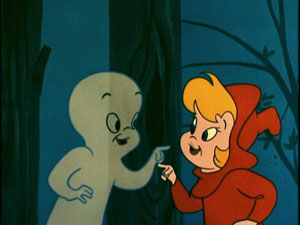
The Sweatbox Review:
Animator Joe Oriolo and writer Seymour V. Reit first came up with a story about a friendly ghost in 1945 and submitted their unpublished children’s book to Famous Studios. Famous Studios quickly bought the idea and released the first Casper cartoon, The Friendly Ghost, in 1945 and it was written by Bill Turner and Otto Messmer. The public’s response was average, but the studio still came out with the sequel the next year called There’s Good Boos Tonight. In 1949, Casper starred in a comic book published by St. John Publishing and this is where he first got his name. However, the comic books were not very successful either and people found them repetitive. Much like the two theatrical shorts, the comic book stories followed Casper in his eternal search for a friend. When Harvey Comics purchased the rights the next year, they began to analyze the problem and decided to give him a family and friends that followed him in the stories.
A typical Casper cartoon begins with Casper unsuccessfully looking for a friend, scaring many humans and animals (and sometimes objects) along the way. Eventually, he always finds a friend in a small creature or child without prejudice and they end up having a great time. Then, in the middle of the cartoon, they typically encounter a problem, and Casper has the opportunity to rise for a heroic ending. By the late 50s, Famous Players started adding some of Casper’s regular comic book friends to their cartoons, revitalizing the series. Even though most cartoons had more-or-less the same plot, Casper managed to outlive all of his Famous Studios friends, with the exception of Herman and Katnip, until his last theatrical cartoon, Casper’s Birthday Party, premiered in 1959.
Along with Casper’s last theatrical short came a new beginning for Casper on television. His theatrical shorts began appearing that same year in Matt’s Funny Fundays, and by 1963 he had his own show, appropriately called Casper the Friendly Ghost. Joining him were his friends from the cartoons – Wendy the Friendly Witch, Casper’s cousin Spooky the tough ghost, Nightmare the talking ghost horse, and the popular Ghostly Trio who lived with Casper. These cartoons lasted until 1970 and later on Casper returned in the least successful of his cartoon incarnations: Casper and the Angels, a Hanna-Barbera spoof of Charlie’s Angels that had Casper fighting crime in space! Casper was very popular at this time and he was a “spooks”-person for many organizations such as UNICEF, GE, Major League Baseball, the American Dentist Association, the Boy Scouts, and even Apollo 16th’s flight to the moon. In 1995, the hit feature film, Casper premiered, briefly revitalizing interest in the character. This led to a popular new cartoon series that ran from 1996 to 1998 on FOX, several direct to video releases, and now a DVD of his classic shorts.
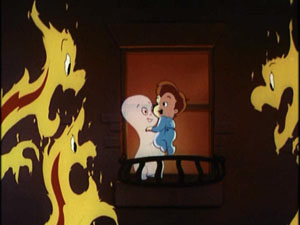
There are four cartoons which fit the basic formula of Casper looking for a friend. Included in this group are many of his earliest cartoons. These are To Boo or Not to Boo, The Deep Book Sea, Frightday the 13th, and Boo Ribbon Winner. The cartoons here all have the basic premise of Casper trying to make friends, scaring some people along the way, and finally making one and then proving himself to the people who were scared by him.
The first cartoon, and the first in the DVD, is To Boo or Not to Boo (1951). Here, we find Casper on Halloween night looking for friends. Since it is Halloween, it is easy for him to pretend he is just a kid with a blanket. However, his ghostly powers give him away and people shriek (“A Ghost!”) and run away. Eventually, Casper finds a costume party where he becomes friends with a girl named Lou. This is a cute cartoon, and it has a good surprise ending. While not the best, it does set the tone for the rest of the cartoons. A similar cartoon is The Deep Boo Sea (1952) where Casper leaves Fright School to go find a friend on the seashore. Eventually, he makes friend with a small boy who wants to be a pirate and they begin to hunt for a treasure chest. Again, while not the best, it certainly remains true to the original formula with a climatic ending where Casper proves his worth.
Two of the friends Casper makes in these cartoons are animals. In Frightday the 13th (1952) the ghosts become excited that it is finally “Frightday the 13th” when they can scare people, but Casper, as usual, wants to go out and find a friend instead. Here, Casper befriends a small black kitten people consider unlucky. Together, they go and look for a good luck charm for the cat which he names Lucky. This is more of a comical cartoon as we follow Casper and Lucky desperately trying to find a good luck charm. Most of the good luck charms fail miserably, but in the end it turns out well. In a visibly later-day cartoon, Boo Ribbon Winner (1954), Casper makes friends with a lazy, overweight, greyhound dog, named Molasses, who is being threatened with the pound unless he wins that day’s race. It ends rather predictably, but the humor found here is cute and it is funny to see Casper being so frustrated with this new friend.

The second type of Casper cartoon are the ones that feature friends Casper has already made. This was probably because the cartoons were getting really repetitive; although I am sure many people were wondering why Casper never maintained his friends from the previous cartoons. In these cartoons, we see Wendy, Spooky, Hazel, and Casper’s ghost buddies sharing in the limelight.
The earliest of these cartoons is Hide and Shriek (1954) where Casper is sitting next to the window of his haunted house bored, and without a friend to play with. This cartoon marks the film debut of Casper’s cousin Spooky who is coming to visit him. Spooky, looking much different from his future self, arrives and all Casper wants to do is play hide-and-go-seek. Much to Casper’s displeasure, all Spooky wants to do is scare innocent creatures throughout the countryside. It is then up to Casper to teach him a lesson. Another cartoon that features Spooky is Hooky Spooky (1957). In this cartoon, Spooky believes he has scared a small bear to death. This gives Casper another opportunity to teach him a lesson about scaring others. This is actually one of the better cartoons and Spooky shows that he can become an interesting character to balance Casper’s friendliness.
Fright From Wrong (1956) focuses on Casper’s ghost buddies. They are bothered by Casper playing with birds in the field. They blame him for making the birds immune to their shrieks and pranks. After calling Casper into their house, they force him to take a pill that will make him mean. Casper then turns into a little devil and beings to wreak havoc on the ghosts. After Caper becomes mean, he performs all sorts of evil pranks on the ghosts. This is one of my least favorite cartoons. With a confusing ending, it makes one wonder why Casper is only willing to make friends with animals and humans and not other ghosts.
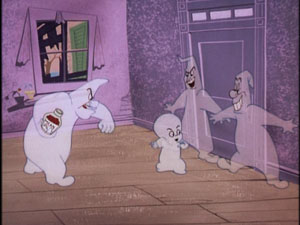
Finally, the last two cartoons feature his best friend Wendy – Which is Witch (1958) and Wendy’s Wish (1962). Both of these cartoons have Casper and Wendy doing something together. In Which is Witch, Casper is taking Wendy on a date to the beach after leaving Spooky who really wanted to play baseball with Casper that day. Spooky then proceeds to sabotage Casper’s date and make it look like Casper is doing it. Wendy falls for it and demands to be taken back home. It ends with Spooky learning a valuable lesson about girls. In Wendy’s Wish, Casper and Wendy wish upon a star for the same thing: for Wendy to get a pair of red dancing shoes. Casper gets Wendy her dancing shoes only to find that it has been cursed by the Witch Weevil. Now Casper must ask the witch to help him. Both cartoons are good in the sense that they stray from the Casper-looks-for-a-friend formula and they are funny and filled with plenty of visual gags.
The third type of Casper cartoon has Casper getting involved in adventures to exotic locations during his quest for friends. These include my favorite Casper cartoons and they are the most entertaining.
Ghost of the Town (1952) is probably one of the best early Casper cartoon in this set. While other ghosts are involved in an army-like “Operation Scare,” Casper is picking flowers under the moonlight. He then goes to the big city to, you guessed it, find some friends. There, he finds a burning building with a baby crying on the top floor as he is being engulfed by the flames. Casper goes to save him and brings him down to his mother. He becomes an instant celebrity and even makes an appearance on the Ed Sullivan Show. This prompts the other ghosts to plan an attack on the television studios. The story is clever and even continues in a semi-sequel, named Not Ghoulty (1959). Not Ghoulty is even better. It has one of the best dialogue scenes on this set and it even rhymes. Here, Casper is put on trial for being friendly to people and showing them that they have no reason to be afraid of ghosts. He is found guilty and loses his ghostly powers until he scares someone. This becomes a problem since many of the people in town have come to rely on Casper to help them in certain situations and Casper seems to forget that he has lost his powers. The resolution is a clever one and it even left me wondering. Certainly, these two are the highlight of the set.
The other three adventures have Casper going to other places. In Boo Moon (1953), Casper decides to visit the smiling man on the moon only to discover that there is nothing there. In a Gulliver’s Travels twist, Casper finds himself prisoner to a race of tiny moon people. When they are attacked by some walking trees (yes trees on the moon), the moon people try to get rid of them by throwing fire arrows at them. This works until the trees spit water back at them. Casper then goes to help the moon people and saves the day. This was Casper’s one and only 3D cartoon and it is easy to tell where the 3D would have made a difference. While we have to suspend logic, the story is clever as it spoofs Gulliver’s Travels. In Spooking About Africa (1956), Casper is in jungle (yes looking for a friend), when he finds a misfit elephant who sneezes a lot. Casper then tries to cure the elephant. In Boo Bop (1957), Casper visits the Museum of Music. There he meets the ghost of Franz Schubert who is trying to finish an Unfinished Symphony on his piano. Casper just sits, listens, and tries to eliminate any noises coming from the streets. This is another great Casper cartoon and the animation and backgrounds are reminiscent of other cartoons of the era.
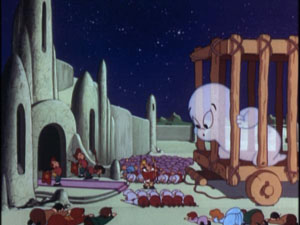
Is This Thing Loaded?
In short, no. The only real ‘extra’ on this DVD is the original opening for the Casper television show from the 50s. It would have been nice to see some sort of Casper filmography or more things about Casper and his fifty years as a cartoon character. Unfortunately, none of this is included.
Case Study:
This release comes in a regular one disc DVD case. The cover features both Casper and Wendy prominently in their classic cartoon form. The cover has an orange border, I suppose to tie the release in for Halloween.
Ink And Paint:
I have found it to be normal for fifty-year-old theatrical cartoons to have a grainy picture, and Casper is no exception. Most of the cartoons have blemishes and grains that are clearly visible. It is difficult to tell whether the transfer was made from original negatives or from other material. All of the cartoons are presented in the full screen 1.33:1 ratio.
Scratch Tracks:
Casper is presented in Dolby Digital Stereo and it is not bad. For cartoons that are nearly fifty years old, the sound quality and transfers are relatively good. The DVD comes with the original Casper theme song from the television show and it also plays in the menu. Sometimes the sound felt distant, or like in an empty room, but overall it was not bad.

Final Cut:
These are cartoon classics, and most of them are funny. They are, and have always been, intended for children. Children will be able to connect with Casper and his search to make friends. Growing up, I know I was able to identify with Casper and his quest to make new friends. Casper, as the ghost who does not want to scare others, is the perfect misfit and he is always a good role model for children. There is always a moral lesson in each story and the stories are easy to follow. I still do not understand why Sony had to put Wendy as a title character when it is clearly Casper’s show. In the end, this is a good addition to the collection of anyone who ever enjoyed Casper growing up. It is a comfortable to always know that everything will turn out right in the end and that being good can be rewarding.
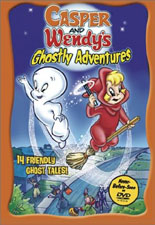 | ||
 |









